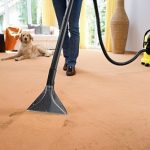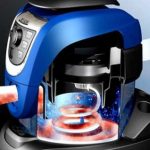For people suffering from allergic reactions of various origins, careful cleaning of the premises is especially important. To thoroughly get rid of “irritants” in the house, home appliance manufacturers have created a special line of vacuum cleaners for allergy sufferers. According to the creators, this product is a unique development that can reduce the risk of exacerbation of reactions in people prone to such phenomena, especially in a typical period (spring / autumn).
What is the difference between vacuum cleaners for allergy sufferers and their "ordinary" counterparts? Are the features of their design really able to save a person from most allergens in the apartment? And also how to correctly choose the most suitable model for yourself, relating to the ranking of the best of 2019? Let's get it right now.
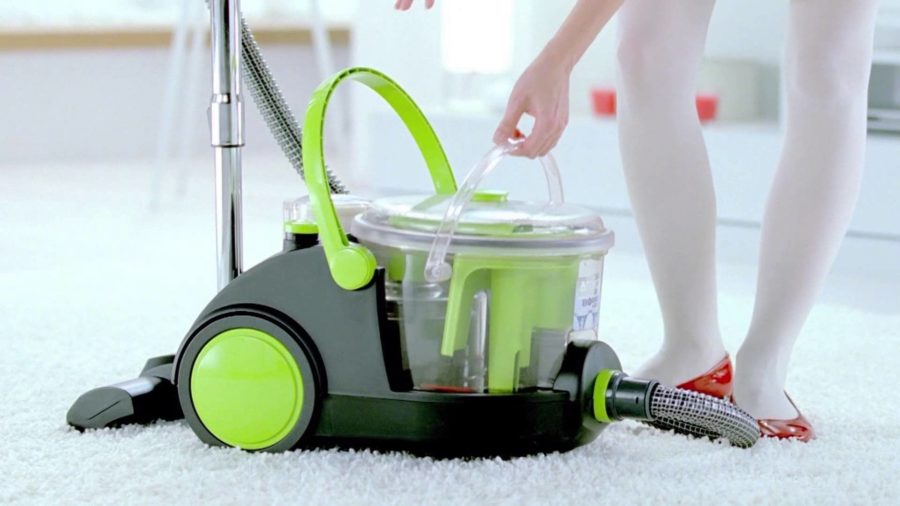
Content
What it is
Various variations of the "execution" of household appliances, in particular vacuum cleanersToday no one is surprised. Manufacturers try to think through the maximum of details related to the quality of the material, the shape of the case, dust collectors, nozzles and so on. All of the above developments are designed to facilitate the life of the user and, as a result, the person’s readiness to acquire a “new assistant” if the previous vacuum cleaner fails. One of the latest developments in the field of purpose of vacuum cleaners is the design of devices specifically for allergy sufferers.
Their main difference from previously released analogues is the built-in HEPA filter (High Efficiency Particulate Air or High Efficiency Particulate Absorbing) provided by the manufacturer. This type of filter is also known as a fine filter, designed to highly dust-free the “processed” room. It is worth emphasizing that a thorough cleaning of an apartment or house from a large accumulation of dust is necessary not only for people who are prone to allergic reactions directly to dust. Large fractions of contaminants can contain bacteria, pollen, skin particles, animal hair, ticks, germs, book dust, and so on - in other words, they contain everything that can be considered potential allergens.
In HEPA-vacuum cleaners for allergy sufferers, this type of filter is used as the "finish", namely in order to minimize the risk of re-entering the collected dirt into the "processed" room. Accordingly, the main functional elements of devices of this class can be aqua filters, and cyclone tanks, and static, and many others. The design of HEPA cartridges, as a rule, is based on a cleaning fibrous material folded "in a pea". The element selected by the manufacturer for cleaning the room from particles potentially hazardous for allergy sufferers is built into a steel or cardboard frame. The process of filtering directly using HEPA filters consists of three stages:
- "engagement";
- "inertia";
- "diffusion".
In addition to the presence of a fine filter, vacuum cleaners designed for people prone to allergic reactions are traditionally supplied with a variety of brush heads that can “remove” dirt from even the most inaccessible places, such as furniture joints, crevices, and so on.
When deciding on the advisability of buying a vacuum cleaner, declared by manufacturers as a “gadget for allergy sufferers,” it’s worth bearing in mind the most common advantages and disadvantages of their use, which users who had a “word for word” faced with marketing brands.
The positive aspects of cleaning the living space through the devices of the segment in question include:
- retention of the already collected amount of dirt and dust inside the design of the vacuum cleaner, thanks to special filling tanks that exclude debris from their construction;
- the ability of the vast majority of gadgets for allergy sufferers to absorb dust without lifting it up, thereby minimizing the risk of allergen getting into the airways of the user;
- elimination of the probability of propagation of harmful bacteria, fungi, mold, and so on inside the device itself, due to a well-thought-out design and a variety of simple ways to care for it;
- the possibility of cleaning the dust bag, regardless of its fullness, after each cycle of cleaning the apartment or house, which ensures the minimum risk of the spread of the allergen after it is collected in a household appliance;
- a well-thought-out method of “processing” containers for collecting dirt and dust, eliminating direct user contact with potential allergens.
The main disadvantage of using a vacuum cleaner designed for allergy sufferers can be considered the fact that it is impossible to completely exclude contact with dirt from the user. No matter how thoughtful the design of the dust collector itself, as well as the method of cleaning it, an allergic person will be forced, albeit for a short time, to face “possible irritant” “face to face”. Moreover, when planning to buy a home appliance of this type, the buyer should understand that he will not become a panacea for the onset or exacerbation of an allergic reaction. Using such a vacuum cleaner in order to minimize the risk of relapse, one should not forget about the medication prophylaxis prescribed by the attending physician.
How to choose
After making sure that the functional processes of the gadget for allergy sufferers are well thought out, as well as understanding its advantages over their “colleagues”, the buyer has a logical question about choosing a vacuum cleaner model, with the expectation that it will become the best in his particular case. What characteristics should you rely on when analyzing a range of household appliances in a store?
Firstly, the presence of a HEPA filter. As described above, it is this cleaning element of the vacuum cleaner that allows manufacturers to call their product "device for allergy sufferers." Using a HEPA gadget, the user can be sure, at least, that the dust that he has already collected will not spread again throughout the room during the cleaning process.
Secondly, the buyer should give preference to a vacuum cleaner with a high level of power. Low-power equipment rather “raises” dust into the air, rather than sucks it. The consequences of such cleaning can be a relapse of allergic reactions, due to direct prolonged contact of the user with allergens contained in the mud. A high level of power will not only ensure high-quality cleaning of the room, but also the speed of this process, which will significantly reduce the risk of exacerbations.
Thirdly, in choosing a vacuum cleaner for allergy sufferers it is important to make sure that the dust collector can be cleaned of contaminants after each cycle of “processing” the room. In the absence of this function, it is worth evaluating the quality of dirt “retention” (the tightness of the dust reservoir design) and the likelihood of “infection” of the mechanism of the household appliance itself, which in the future may cause the spread of allergens in the apartment or house where the vacuum cleaner is directly stored.
For a better understanding of the information described above, we suggest that you familiarize yourself with the following list of top models presented on store shelves in 2019, as well as their technical components.
The best models
Thomas Allergy & Family
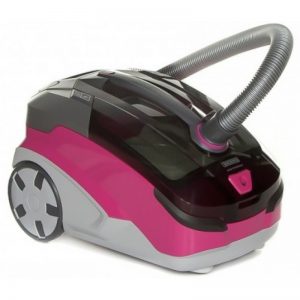
- Types of cleaning: dry, wet
- Maximum power consumption during operation: 1700 W
- Dust collector type: aquafilter
- Dust container capacity: 1.90 L
- Noise Level: 81 dB
- Cable length: 8m
- Weight: 8 kg
- Additional nozzles: there is (floor / carpet; Aqua Stealth for wet cleaning; horse hair parquet; for cleaning upholstered furniture; elongated crevice; spray for wet cleaning of upholstered furniture)
- Built-in options: fluid collection function, power regulator integrated in the housing, fine filter
- high suction power
- sufficient cable length
- "Extended" complete set of nozzles
- maneuverability
- ability to purify indoor air during operation
- high noise level during operation
- build quality
- case material
- lack of a special container for storing nozzles
- heavy weight of the device (especially filled with water)
If you prefer this manufacturer, then it will not be superfluous to get acquainted with other representatives of the model range vacuum cleaners thomas.
Dyson DC37 Allergy Musclehead
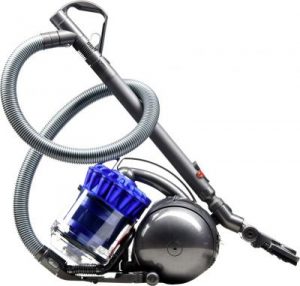
- Types of cleaning: dry
- Maximum power consumption during operation: 1300 W
- Suction Power: 290 W
- Dust collector type: cyclone filter
- Dust box capacity: 2 L
- Noise Level: 82 dB
- Cable length: 6.5m
- Weight: 5.2 kg
- Additional nozzles: there is (for upholstered furniture; crevice / brush; universal Musclehead with automatic switching modes for cleaning all types of coatings and under low-furniture)
- Built-in options: approved by researchers for allergy sufferers, the presence of a fine filter
- maneuverability
- acceptable noise level
- simplicity of leaving and operation
- case material quality
- appearance
- lack of regulators on the device handle
- inconvenient "blowing" of hot air into the floor
- electrostatic material of the housing
- low quality of individual fasteners
- insufficient suction power
Thomas Perfect Air Allergy Pure
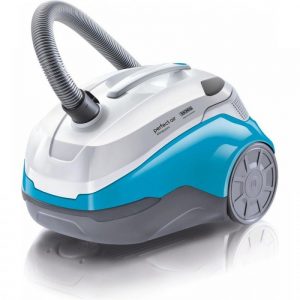
- Types of cleaning: dry
- Maximum power consumption during operation: 1700 W
- Dust collector type: aquafilter
- Dust container capacity: 1.90 L
- Noise Level: 81 dB
- Cable length: 8m
- Weight: 7 kg
- Additional nozzles: there is (floor / carpet, nozzle brush for furniture, for cleaning mattresses, crevice)
- Built-in options: liquid collection function, fine filter, vacuum cleaner power regulator located on the body
- compactness
- appearance
- sufficient suction power
- air cleaning during cleaning
- easy to clean aquafilter after each use
- lack of dust collector indicator
- the ability to adjust the power through the buttons on the handle is not provided
- low quality hose
Dyson DC42 Allergy
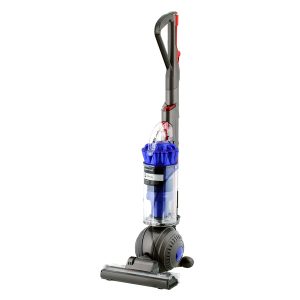
- Types of cleaning: dry
- Maximum power consumption during operation: 1100 W
- Suction power: 200w
- Dust collector type: cyclone filter
- Dust container capacity: 1.60 L
- Noise Level: 83dB
- Cable length: 7.5m
- Weight: 6.7 kg
- Additional nozzles: yes (crevice / brush; for upholstered furniture, electric brush)
- Built-in options: the presence of a fine filter
- sufficient suction power
- vertical storage option
- ease of cleaning the dust bag
- light weight
- bulkiness
- low maneuverability
- “Tight” cable
- high noise level during cleaning
Miele SHJM0 Allergy

- Types of cleaning: dry
- Maximum power consumption during operation: 1500 W
- Dust Collector Type: Cloth Bag
- Dust box capacity: 6 L
- Weight: 9.7
- Cable Length: 10.5
- Additional nozzles: there is (for a backlit floor for efficient cleaning of dark places; long crevice; for cleaning upholstered furniture; hand brush with natural bristles)
- Built-in options: the presence of a fine filter, a vacuum cleaner power regulator located on the housing
- "Extended" complete set of interchangeable nozzles
- low noise in direct use
- maneuverability
- fabric dust collector
- body material
- high cost of supplies
Based on the above information, we can conclude that there is a high probability of choosing the “ideal” vacuum cleaner for allergy sufferers with any requests and opportunities.Using our tips, buying a device for cleaning the room will deliver the user exclusively positive emotions.

